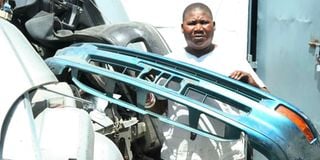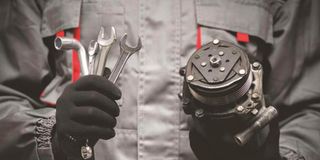Premium
Spare parts prices are a ‘bum’ deal, one way or another

Irene Oluoch, the managing director of Nagoya Auto Parts Limited, displays some of the vehicle spare parts at her showroom in Mombasa.
Why are original spare parts so pricey? After all, they are exactly the same as the parts used to make the vehicle in the first place and they are made with huge economies of scale, yet if you built a car entirely from those same original spare parts it would cost at least 10 times as much as the complete brand new car they were made for. Weh!
Ephantus
Short answer: It is all about a global motor industry strategy known as “bums on seats”.
Longer answer: That slogan that means put sales volumes ahead of profit margins on new car sales…and then make the real money later, on parts and service.
Makes sense. After all, you only sell a new car once. You sell parts dozens of times… to all its owners… throughout its life. Also, if a new car is expensive, buyers have a lot of other choices, but when it comes to genuine parts, the original manufacturer is the only supplier for those who have bought that brand. Whether they bought new, or second or sixth hand.
This principle has been an anchor of motor industry strategy, worldwide, for many decades. New car prices are extremely competitive, with discounts, special finance deals and very tight margins. Spare parts prices (and service) are eye-watering. That doesn’t deter new car buyers, because they usually sell on before many (or any) spare parts are required.
The bums of used car buyers then get on those seats for even lower purchase prices…and start paying the bills at the spares counter and in the workshops. And as each car passes from bum to bum, the purchase price keeps going down, down, down, and the need for expensive parts keeps going up, up, up.

Auto mechanic showing a broken air conditioning compressor.
So, getting bums on seats of new cars – even at cost price – keeps paying dividends to the original manufacturer all the way along the resale chain. Most Kenya motorists cannot afford to play that game, but neither can they truly escape it. The first problem is that the most competitive new prices are granted to national distributors who order several thousand cars at a time. But there are no bargain deals when a national distributor orders, say, half-a-dozen (as Kenya’s motor companies do). Our new car “cost price” is unusually high, it is heavily taxed, too, and volumes are so low and the parts market is so wild that high first-sale margins are a business imperative. What Kenyans pay for a bog-standard pick-up would buy an exotic muscle car in many major markets.
So, most Kenyans buy super low-priced used cars from other markets, and policy grants them a considerable tax discount, too. The older the better! But this remedy and policy swamps us with cars that need lots of spare parts; potentially very expensive parts. So we solve that by importing parts that are amazingly cheap…because they come from junk manufacturers, or from bandits, or from scrap heaps.
One problem solved, many more problems created. Because our new car volumes are thence even lower their cost price is even higher. The same syndrome affects the genuine parts process, too, so they become doubly exorbitant. One way or another, we have to buy a lot of parts (or run defective cars), and if those parts are cheap junk we have to buy them even more often (and suffer severe reliability and performance penalties as well).
All is not lost. The truly cheapest spare part is one that remains on the shelf – because the original part is high quality, has been used carefully and maintained properly. When a functionally important replacement part is needed, buy quality and look after it.
Keeping up appearances
Each time I open my car bonnet at the filling station to either have the oil checked or fill wiper water, I feel embarrassed because the engine is always dusty. I keep reading that engines should not be tampered with often, including having them washed at the car wash. How do I keep my engine clean at home?
Carol W.

High pressure water cleaning car engine.
Short answer: Car engines can be simply and safely cleaned at minimal cost by anybody who knows some basic do’s and don’ts.
Start by wiping everything under the bonnet with a damp cloth, frequently rinsed and wrung out, and get more ambitious from there.
Longer answer: Although all the stuff under the bonnet might look like a Pandora’s Box to the non-technical, everything in there has to be quite robust and fairly weather-proof otherwise it would not survive regular use. After all, the engine compartment has no floor and is open to the road below, and it is frequently splashed with water from puddles, and mud, and oil spills, and dust. That is why engines get dirty in the first place. There are under-bonnet parts which get red hot and are also subject to fearsome shaking if the road is rough.
Almost everything in the engine compartment has nothing to fear from you armed with a damp cloth and some soap or solvent cleaning fluid. At the same time, none of it has been designed to work as a submarine, so while plenty of vigour is okay in most places, (even spray from a hosepipe or pressure washer) a little discretion is called for.
First timers can begin with just a damp cloth. You can wipe anything and everything you can reach with that, safely. If you come across patches that are oily, emulsify those with a dab of petrol or kerosene or a branded engine cleaner. For patches of caked mud that need to be scraped off, use a soft plastic or wooden utensil to avoid scratches.
As you make this debut, try and figure out the parts that are likely to be most sensitive to “flooding” with water (everything must be able to handle a little indirect spray…or a damp cloth).
The bits that might not do well with copious streams of water are the alternator and (in petrol engines) the distributor cap, the coil and their electric cable leads. Go carefully near old-fashioned battery caps (which have breather holes in them). Take care not to get water inside the air filter. Equally, you don’t have to hermetically seal these things. A little overspray while washing other things will do no harm.
As you build understanding and confidence, common sense will guide you on where to use a rag on bigger surfaces, where to use a paintbrush to get into awkward corners and so on, and improve your dexterity with a hosepipe for rinsing.
In this learning curve, it can be helpful to have the engine warm before you start (for your own sake not too hot) and to start the engine as soon as you have finished to accelerate drying even in hidden away crevices and near electrical connections, and demolish potential drips.
Wheel trims – for and against
My wheel caps were stolen a year ago on Kenyatta Avenue where I’d parked my car. I decided to replace them recently with wheel caps that cost me Sh20,000. The other day, I realised that one of the wheel caps had cracked. I was so disappointed, since Sh20,000 is not 2 shillings. Question is, is it dangerous to keep driving with the cracked wheel cap? What caused the crack? Also, is there a particular brand of wheel caps that are better than the other?
Kelvin
Short answer: If by wheel caps (also known as hubcaps or wheel trims) you mean the ones that cover the whole outside face of a wheel rim, then I have at least one piece of good news for you:
On ordinary cars they are purely cosmetic, are not essential to any function of the car, and the only danger they present is if they fly off down the road or across the pavement like manic frisbees. To avoid this, you can simply remove them and carry on without. The best brand of wheel trim may be no wheel trim.
Longer answer: Their only job is to make the car look better, and some of them certainly do that. Others certainly do not judging by the garish displays of scavenged (or stolen) caps that decorate some roadside kiosks.
Their job is purely to hide the ordinariness of a pressed steel rim, and to add some bling. They may even be slightly counter-productive, by blocking some of the cooling breeze which helps dissipate heat generated by the brakes.
The only utilitarian value of some designs in some circumstances is that they can fractionally improve the aerodynamics (reduce the drag) of a vehicle negligibly at under 100kph, and still only minimally (though exponentially) at two or three times that speed.
Happily, hubcaps are phasing out thanks to the increasing popularity of alloy wheels, which do an even better job of making a car look good. They are also functionally superior in lighter weight and greater strength.
Unhappily, wheel trims which remain do not often follow the example of older French cars, which always kept their hubcaps held on with a central bolt of the same size as the wheel nuts (so the regular wheel spanner could be used to undo them for a wheel change).
Without specifics about the type and location of the crack on yours, or the overall nature of the hubcaps themselves (chromed plastic or real metal or not much more than tinfoil) the cause could be anything from heavy-handed fitting /removal to another attempted theft, or being hit by something (like a kerbstone) and, depending on where your hubcaps were made, simply shoddy manufacture.
Do you have a motoring question? Email [email protected]





